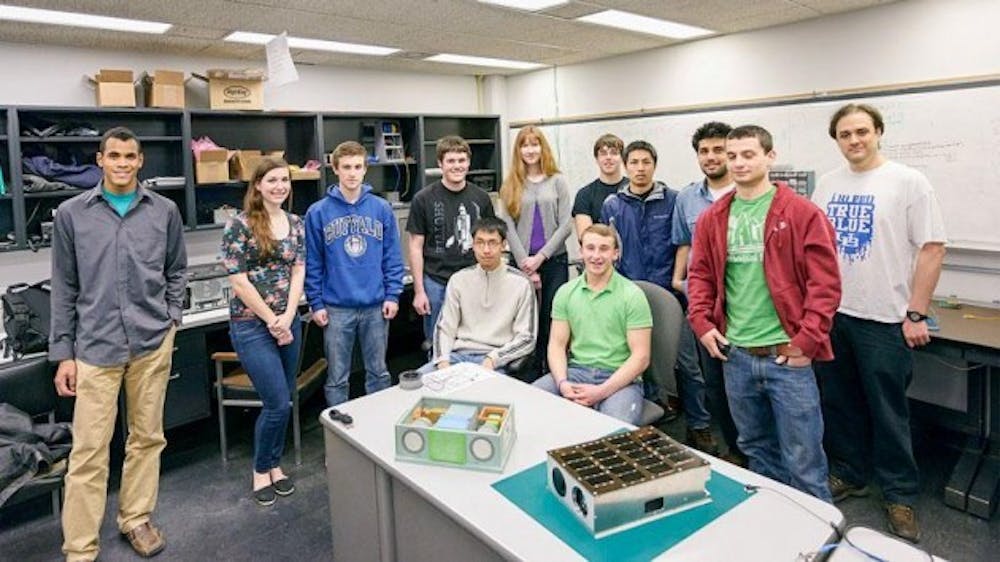A team of UB engineering students is shooting for the stars.
The students built a satellite that will track space debris to help avoid possible collisions. The team's 'shoebox-sized' nanosatellite, Glint Analyzing Data Observation Satellite (GLADOS), won a NASA launch spot and will be launched into space by "riding" on a NASA rocket.
On Feb. 4, Russian scientists noticed one of their satellites had not only changed its orbit but also its spin velocity and orientation after possibly colliding with a fragment of a Chinese satellite, which was blown up in 2007. The Russian's satellite is thought to have lost its function, according to CNN.
GLADOS will help prevent events like this from occurring again.
John Crassidis, professor of aerospace engineering and principal investigator of the project, could not hide his anticipation for the launch. Although he admits being nervous about sending GLADOS into space, he is also "super excited" to see it fulfill its mission.
"I know, once we get it up into orbit, it's going to work fine," Crassidis said, smiling from ear to ear. "[The students] are going to do a good job and when we start collecting data, that nervousness is all going to change into excitement."
GLADOS is equipped with two cameras ? an infrared and a visible camera ? to gather the brightness level of space debris as light is reflected off them. With such photometric data, students can determine various critical information of the debris they are tracking, like mass, shape and material composition. These pieces of information help scientists predict the orbital path of the debris and take measures to prevent collisions.
Despite the significance of its mission, GLADOS is relatively affordable ? the prototype cost around $110,000 to design and build, according to Nikita Butakov, a senior electrical engineering major and chief engineer of the project. The ultimate goal is to create a network of these kind of nanosatellites that serve as a sophisticated, cost-effective alternative to current systems that are much more expensive, like the Space Based Space Surveillance (SBSS) system.
Building GLADOS began as an extension of Crassidis' research on tracking space debris. He realized collecting photometric data from space would yield more accurate results about the debris.
"The mother of invention is necessity," Crassidis said. "You always ask, 'Why would I want to put something into space when I can put it on the ground?'"
As a result of this "necessity," students drew up a proposal to build GLADOS and received funding from the Air Force to build the prototype.
More than 150 students have worked with the project since its inception a little more than two years ago as part of the University at Buffalo Nanosatellite Program, according to Butakov. Currently, there are about 40 students working on GLADOS. To coordinate research and building efforts, the team is split into subsystems that are in charge of different aspects of the project.
"[The organization] seems to work out pretty well," said Richard Linares, a doctoral student in aerospace engineering and student principal investigator. "Through reviews and major milestones, we get to see all the progress that has been made and how everything fits in together."
Students said being involved in the project has been a multifaceted experience. They not only get to develop a deeper understanding of their fields of study but also hone soft skills, like leadership and management. In addition, through attending conferences and working with private organizations, students get valuable networking opportunities.
In order to obtain a launch spot under NASA's CubeSat Launch Initiative (CSLI), GLADOS competed against satellites designed and built by other universities, private companies and NASA. It eventually emerged as one of 24 satellites selected to go into space.
Although CSLI is still active, many other NASA programs that support science, technology, engineering and math (STEM) education, like outreach initiatives, have been suspended in light of budget cuts.
"Personally, I'm working for NASA this summer doing an internship, and I'm kind of nervous whether I will still have the internship or not because of the budget cuts," said Kristina Monakhova, a freshman electrical engineering major and co-lead of one of the subsystems. "I think it's really sad that we have to cut funding from such great [programs] and I wish we didn't have to do that."
The team is working hard to get GLADOS ready for launch. It's recruiting new members to help out with the preparations.
Although there is no set date, GLADOS could be launched as early as 2015.
Email: news@ubspectrum.com





